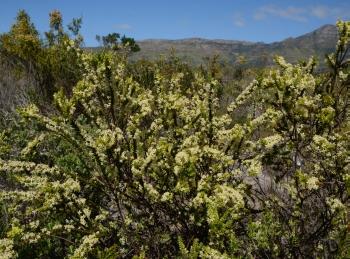Struthiola striata
Struthiola striata Lam.
Family: Thymelaeaceae
Common names: roemenaggie, katstertjie (Afr.)
Introduction
A pretty shrub with four petaloid scales and cream-coloured flowers, honey-scented at night.

Description
Description
Shrub up to 1.5 m high. Leaves opposite, suberect, overlapping, sessile, ovate to lanceolate, concave, appressed-ciliate on margins when young. Inflorescence a terminal spike.

Flowers cream-coloured, honey-scented at night, tube cylindrical, ± 10 mm long, appressed-pubescent; sepals 4, ovate-subacute, glabrous but 2 outer sepals penicillate; petaloid scales 4, elliptic, fleshy, surrounded by stiff hairs longer or shorter than the scales. Stamens 4, sessile in single whorl, inserted ± 1 mm below mouth of hypanthium, apical callus reddish. Ovary ovoid; style, ± reaching halfway up calyx tube. Plants flower from September to June.
Conservation Status
Status
Struthiola striata is currently listed as Least Concern (LC) in the Red List of South African plants.
Distribution and habitat
Distribution description
The species occurs from Yzerfontein in the Western Cape to Uitenhage in the Eastern Cape, on coastal sand flats, in fynbos.

Derivation of name and historical aspects
History
The generic name is derived from the Greek word strouthos, a ‘small bird’ or ‘sparrow’, referring to the calyx-remnant of the fruit that resembles the beak of a sparrow. The specific epithet is derived from Greek word stria meaning a ‘furrow’ or ‘channel’, referring to the longitudinal furrows that form at the back of the dry leaves.
Struthiola is a largely southern African genus of ± 40 species, with 3 or 4 species also in tropical Africa (Peterson 2006; Manning & Goldblatt 2012). In South Africa the genus is mainly concentrated in the Greater Cape Floristic Region of the Western Cape (Manning & Goldbaltt 2012), with a few species extending to KwaZulu-Natal.
The number of petaloid scales has been used in the past to distinguish 3 main groups within the genus, namely those with 4, 8 or 12 scales. The 4-scaled group consists of 2 species, S. striata and S. tetralepis. These species are distinguished from each other in that S. striata has ovate sepals and cream-coloured flowers, whereas S. tetralepis from the Hottentots Holland Mts, has lanceolate sepals and greenish yellow flowers that fade to red.
Ecology
Ecology
The pale flowers with slender floral tube, included anthers, and nocturnal fragrance, are characteristic of moth-pollinated plants, and this has been shown to be true for S. ciliata.

Uses
Use
None recorded but the species has significant horticultural potential for coastal gardens. Plants are quick-growing with a tidy habit, and are evidently water wise. They flower profusely in late spring, and the flowers are attractively scented at night.
Growing Struthiola striata
Grow
Cultivation requirements are not yet known, but the cultivation techniques suggested for other species in the genus, S. argentea, S. ciliata and S. myrsinites, are likely to apply. We recommend this species for coastal gardens, as it is believed to be wind resilient and drought tolerant.
References
- Beaumont, A.J. et al. 2009. Gnidia (Thymelaeaceae) is not monophyletic: taxonomic implications for Thymelaeoideae and a partial new generic taxonomy for Gnidia. Botanical Journal of the Linnean Society 160: 402–417.
- Makholela, T. & Manning, J.C. 2006. First report of moth pollination in Struthiola ciliata (Thymelaeaceae) in southern Africa. South African Journal of Botany 72: 597–603.
- Manning, J. & Goldblatt, P. 2012. Plants of the Greater Cape Floristic Region 1: the Core Cape Flora. Strelitzia 29. South African National Biodiversity Institute, Pretoria.
- Snijman, D.A. (ed.). 2013. Plants of the Greater Cape Floristic Region 2: The Extra Cape Flora. Strelitzia 30. South African National Biodiversity Institute, Pretoria.
- Wright. C.H. 1915. Thymelaeaceae. In W.T. Thiselton-Dyer, Flora capensis 5(2). Reeve, Kent.
Credits
Thuli Makhoba
Compton Herbarium
January 2018
Plant Attributes:
Plant Type: Shrub
SA Distribution: Eastern Cape, Western Cape
Soil type: Sandy
Flowering season: Spring, Winter
PH: Acid
Flower colour: Cream
Aspect: Full Sun
Gardening skill: Average
Special Features:
Horticultural zones









Rate this article
Article well written and informative
Rate this plant
Is this an interesting plant?
Login to add your Comment
Back to topNot registered yet? Click here to register.